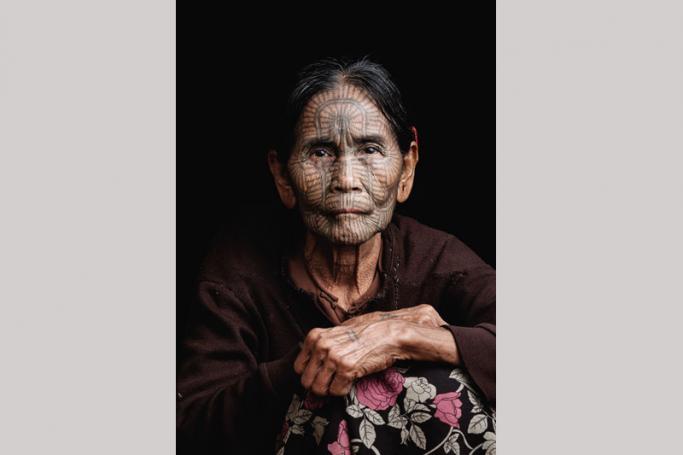An intricate maze covers the faces of the eldest ladies of the Lai Tu Chin people, still living in villages close to Mrak-U, in Rakhine state. Their chins, nose and eyelids display a mesmerising symmetrical pattern, which often emerges from a single circle on their forehead, like a darkened sun projecting its beams on their countenance.
The tradition of tattoo-faced women has been officially banned for decades and, as the few remaining women with facial tattoos grew old, Dylan Goldby, an Australian photographer based in South Korea, decided to document it.
After three different trips to the Rakhine region, where he visited more than 20 villages and interviewed 120 different women between 2015 and 2016, he published a photography book, “Hmäe Sün Näe Ti Cengkü Nu,” which translates as “Women with tattoos on their faces” in the local Chin language.
“I wanted to hear their personal stories, how they felt about their tattoos, and ask about their society’s point of inflection, as they will probably be the last generation that will have those tattoos,” the photographer explained during a talk two weekends ago at Yangon’s Pansuriya café, where some of his pictures were exhibited.
According to several accounts gathered during the trips to the region, getting tattooed was a coming-of-age ritual for the women of the area, and afterwards, they were allowed to participate in local ceremonies, or get married. “All the girls really wanted to do it,” Goldby said.
With the help of a local translator, the ladies also recounted the painful process of getting their faces inked with a steel sewing needle during one or two days.
During one of the interviews, a lady explained that it took her a whole week to finish the process, as she kept running away, “but always returned the next day” to complete the tattoo, said Goldby.
As with many other local traditions, legends and magical stories abounded when the Lai Tu Chin people were asked about how the facial tattoos practice started. Some interviewees told Goldby that the first ones were created to make the women uglier, and spare them from being chosen as concubines by a local king, while others said that the spider web-shaped tattoos allowed them to magically entrap enemies.
The book also looks at other traditions from the Lai Tu Chin people, part of the ethnic Chin minority. Goldby has gathered information about fundamental aspects of the local culture, such as weaving, ceremonial dancing, alcohol-drinking and its religious beliefs.
In the case of religion, the villagers still preserve their animist tradition, summoning nats, or spirits, through spiritual leaders, to heal ill villagers or ask for a good harvest. Despite this, those practices are often mixed with other Buddhist and Christian rituals.
After his project in the Rakhine state region, Goldby has apparently become fond of traditional tattoos and has launched a more significant project, to capture those cultures in which body ink displays still play an important role in Asia.
“It’s a continuation of the project, and I started travelling to places in Taiwan, Laos or north-east India,” he said.
The procedures raised with the sales of the “Hmäe Sün Näe Ti Cengkü Nu” photography book will be donated to We non-profit organisation, focused on promoting access to education.
“The place is so remote that teachers don’t stay there: after receiving an education in the city, they will go back to the village, stay there for a few months and then go back to the city”, said Goldby.
Kickstarter link:
https://www.kickstarter.com/projects/1673152963/the-history-and-culture-...
You are viewing the old site.
Please update your bookmark to https://eng.mizzima.com.
Mizzima Weekly Magazine Issue...
14 December 2023
Spring Revolution Daily News f...
13 December 2023
New UK Burma sanctions welcome...
13 December 2023
Spring Revolution Daily News f...
12 December 2023
Spring Revolution Daily News f...
11 December 2023
Spring Revolution Daily News f...
08 December 2023
Spring Revolution Daily News f...
07 December 2023
Diaspora journalists increasin...
07 December 2023
Euromoney Myanmar Global Investment Forum begins in Nay Pyi Taw












